The Dreams of Benjamin Banneker
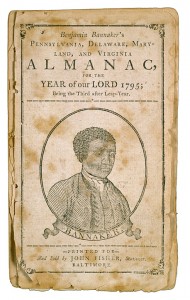
Pennsylvania, Delaware, Maryland and Virginia Almanack and Ephemeris from 1795 with a woodcut depiction of Benjamin Banneker on the cover.
Over the 200 years since the death of Benjamin Banneker (1731-1806), his story has become a muddled combination of fact, inference, misinformation, hyperbole, and legend. Like many other figures throughout history, the small amount of surviving source material has nurtured the development of a degree of mythology surrounding his story. While myths make for great literature and a good story, they also tend to diminish the very real and remarkable accomplishments of such notable figures by casting a faint shadow over the truth. Whatever the truth is, over 50 years before the Civil War, from a log cabin near Ellicott City, Benjamin Banneker was providing evidence for his most important theorem—the universal truth that skin color plays no bearing on the intellectual potential of the human mind, or our shared curiosity and thirst for knowledge.
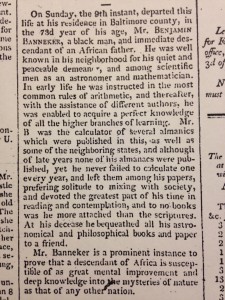
Benjamin Banneker’s obituary from the October 28, 1806 Federal Gazette and Baltimore Daily Advertiser. This obituary shares pages with advertisements offering rewards for runaway slaves.
What does seem to be fact is that Benjamin Banneker was a self-taught (1), free African-American tobacco farmer, whose brilliance in astronomy and mathematics garnered the attention of the most powerful white men in the new nation. With the approval of Thomas Jefferson, Andrew Ellicott enlisted Banneker to assist in surveying the territory which was to become the District of Columbia. After the survey’s completion Banneker would go on to engage in a correspondence with Jefferson about the equal abilities of men of African descent.
Benjamin Banneker was the grandson of an African slave named Bannaka and an English woman named Molly Welsh. In fact, Molly was a former indentured servant who purchased Bannaka and another slave upon her release from servitude, as she needed help working her tobacco farm twelve miles north of the mouth of the Patapsco. As Banneker grew older he began deriving astronomical calculations while gazing up at the stars in the Maryland sky. He was able to accurately predict lunar and solar eclipses, the northing and southing of celestial bodies, and other events in the cosmos, which were ultimately published in his famous Pennsylvania, Delaware, Maryland and Virginia Almanack and Ephemeris from 1792-1797. What is also a fact is that there is not much surviving documentary material about the man; even proving these facts has been a grueling task for previous researchers.
According to Silvio Bedini, who wrote perhaps the most complete study of Banneker’s life, a large chunk of the Banneker scholarship available draws from one of three sources: biographies by Senator James McHenry (1753-1816), John H. B. Latrobe (1803-1891), and A Sketch of the Life of Benjamin Banneker taken from notes by Martha Ellicott Tyson (1795-1873); the latter two can be found here in our library.
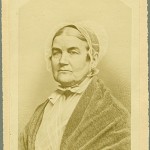
Martha E. Tyson’s (1795-1873) notes about Benjamin Banneker were published decades after his death. The publication was based on childhood recollections and family anecdotes
While Bedini poured over these materials in the H. Furlong Baldwin Library during his residency here at MdHS, he also looked at some other very unique items in our collection. Aside from owning copies of the original Banneker almanacs, MdHS is in possession of the Banneker’s handwritten astronomical journal- one of our most valuable gems.
Though the biographies and sketches of Latrobe and Tyson are invaluable resources, one must keep in mind that they were both based on recollections and written many decades after Banneker’s death. The astronomical journal is the only remaining artifact written in Banneker’s hand, as his cabin and most of his belongings burned down in a fire as his body was being laid in the ground in 1806. On his instruction, the astronomical journal and some other loose manuscripts where removed upon his death and left to George Ellicott (1760-1832). The journal stayed in the hands of the Ellicott family until 1844 when it was deposited here at MdHS, where it was used by John H.B. Latrobe the following year. Quaker philanthropist and MdHS member Moses Sheppard (1771-1857) had the book rebound in Russian leather in 1852, and at this date most likely combined the astronomical journal with some of Banneker’s loose manuscripts as well as a day book. At some unknown date the astronomical journal left MdHS and returned to the hands of the Ellicott family. It stayed there, away from the public’s eye until 1987 when Ellicott family descendant Dorothea West Fitzhugh donated it in honor of her late husband Robert Tyson Fitzhugh. In 1999 MdHS sent the journal to the Center for Conservation in Philadelphia where it was rebound, deacidified, and given full conservation treatment.
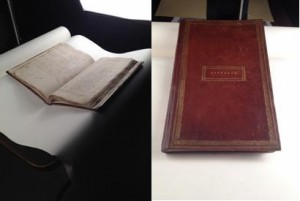
Benjamin Banneker’s astronomical journal was rebound and conserved in 1998. It is currently on display in our Inventing a Nation exhibit.
Some of the more remarkable pages in this ledger show graphic projections for solar and lunar eclipses. In addition to these formulas there are also practical descriptions of how Banneker obtained the geocentric latitudes of planets, the movements of stars, and the different quarters of the moon in every day language.
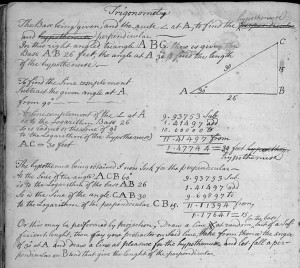
The astronomical journal contains mathematical equations as well as plain language descriptions for determining the motions of the cosmos. MS 2700, MdHS
This journal is much more than a mathematical ledger though—its contents give a much fuller glimpse of who Banneker was as a person. It is interspersed with accounts of his day-to-day life, including descriptions of his interactions with his neighbors and friends the Ellicotts, close encounters with armed intruders on his property, descriptions of the a brood of 17-year cicada from 1749, and the most notable section, a copy of the correspondence between Benjamin Banneker and Thomas Jefferson. But in this writer’s opinion, the most unique contents of the journal are Banneker’s detailed descriptions of the dreams and nightmares that woke him in the night. A transcription of his mysterious dream accounts appear below in chronological order.
December 5, 1791
On the night of the fifth of December 1791, Being a deep Sleep, I dreamed that I was in a public Company, one of them demanded of me the limits of Rassanah Crandolph’s Soul had to display itself in, after it departed from her Body and taken its flight. In answer I desired that he show me the place of Beginning “thinking it like making a Survey of the Land.” He replied I cannot inform you but there is a man about three days journey from Hence that is able to satisfy your demand, I forthwith went to the man and requested of him to inform me place of beginning of the limits that Rasannah Crandolph’s soul had to display itself in, after the Seperation from her Body; who gave me answer, the Vernal Equinox, When I returned I found the Company together and I was able to Solve their Doubts by giving them the following answer Quincunx.
December 13, 1797
I Dreamed I saw some thing passing by my door to and fro, and when I attempted to go to the door, it would vanish and reapted [?] it twice or thrice, at length I let in the infernal Spirit and he told me that he had been concerned with a woman by the name of Beckey Freeman (I never heard the name as I remember) by some means we fell into a Skirmish, and I threw him behind the fire and endeavored to burn him up but all in vain- I know not what became of him but he was an ill formed being- Some part of him in Shape of a man, but hairy as a beast, his feet was circular or rather globular and did not exceed an inch and a half in diameter, but while I held him in the fire he said something respecting he was able to stand it, but I forget his words.
B. Banneker
April 24, 1802
I dreamed I had a fawn or young deer; whose hair was white and like unto lamb’s wool , and all parts about it beautiful to behold. Then I said to myself I will set this little captive at liberty, but I will first clip the tips of his ear that I may know him if I should see him again. Then taking a pair of shears and cutting off the tip of one ear, and he cried like unto a child hath the pain which grieved him very much altho then I did not attempt to cut the other but was very sorry for that I had done I got him at liberty and he ran a considerable distance then he stopped and he looked back at me I advanced toward him, and he came and met me and I took a lock of wool from my garment and wiped the blood of wound which I had made on him (which sorely affected me) I took him in my arms and brought him home and hold him on my knees, he asked the Woman if she had any trust and she answered him in the affirmative and gave him Some, which he began to eat and then asked for milk in a cup She said the dog had got the cup with milk in it under the house but there is milk in the cupboard.
My dream left me. B. Banneker.
April 24, 1802
Being weary holing for corn, I laid down on my bed and fell into a deep sleep and dreamed I had a child in my arms and was viewing the back part of its head where it had been sore, and I found it was healed with a hole through the skin and Skull bone and came out at forehead, that I could see very distinctly through the child’s head the hole being large enough to receive an ordinary finger – I called some woman to see the strange sight, and she put her spectacles on and Saw it, and she asked me if I had previously lanced that place in the Child’s head, I answered in the affirmative.
N.B. the Child is well as any other.
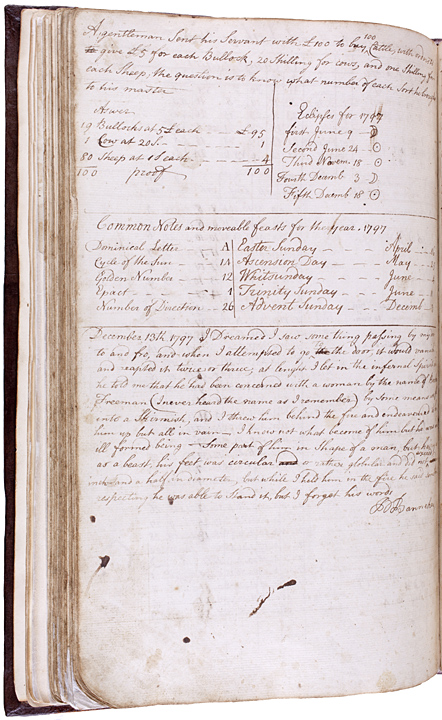
Benjamin Banneker’s nightmare from December 13, 1797 in which he throws a beast into the fire. MS 2700, MdHS
What are these dreams exactly? Are they riddles? Allegorical? Or can they be characterized as curiosities and nothing more? Silvio Bedini describes them as literary essays, but upon further examination it doesn’t seem as easy to lump them together. The first dream, from 1791, which mentions the mysterious Quincunx, certainly seems like a literary essay or myth. Though a quincunx is an ancient Roman unit of measure meaning five-twelfths, in the context of astrology the term also refers to five planets positioned 150 degrees from one another. Most interestingly, the quincunx symbol appears prominently in the Islam-infused religions of Senegal and Western Africa. Could Banneker be alluding to lessons passed down through the generations via his grandfather, the African slave Bannaka? It seems very possible, but we cannot say for sure. The rest of the “literary essays” end abruptly and with little sense of conclusion, the way dreams often do. Is there a connection between the four dreams? Are they unrelated? These questions also remain open-ended. Those interested in reading the dreams in the context of the journal are strongly encouraged to visit the Maryland Historical Society and come to your own conclusions. Though the ledger is restricted to microfilm we happily make the information available for our patrons. For those of you who interested in seeing the physical object, you are in luck, because it is it is temporarily on display in as part of our “Inventing a Nation” exhibit. (Eben Dennis)
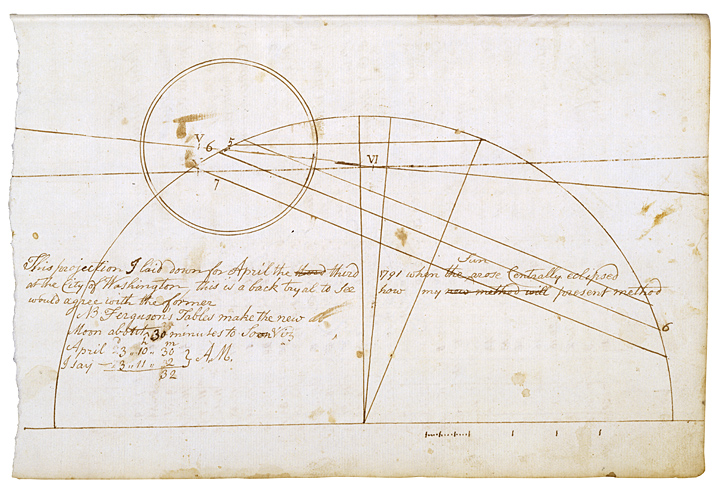
This graphic taken from the astronomical journal depicts a solar eclipse over Washington DC in 1791. MS 2700, MdHS
Footnotes
(1) Though there is very strong evidence that Banneker was tutored in mathematics and astronomy by neighbor and friend Andrew Ellicott, it is also theorized that some of his astronomical knowledge may have come second hand from the Dogon tribe of Africa, being transliterated via his grandmother Molly Welsh.
Sources and further reading
Bedini, Silvio A., The Life of Benjamin Banneker (Baltimore : Maryland Historical Society, 1998)
Latrobe, John H.B., Memoir of Benjamin Banneker: read before the Historical Society of Maryland, May 1st, 1845 . PAM 5201
Banneker Astronomical Journal, 1781; 1790-1802; 1806, MS 2700, Maryland Historical Society
Tyson, Martha Ellicott, A Sketch of the Life of Benjamin Banneker: from notes taken in 1836 (Baltimore: Maryland Historical Society, 1854) https://archive.org/details/sketchoflifeofbe54tyso
Federal Gazette and Baltimore Daily Advertiser. October 28, 1806

